-
 PSG left to sweat on injuries to Dembele and Hakimi
PSG left to sweat on injuries to Dembele and Hakimi
-
Reddit, Kick to be included in Australia's social media ban

-
 Ex-Zimbabwe cricket captain Williams treated for 'drug addiction'
Ex-Zimbabwe cricket captain Williams treated for 'drug addiction'
-
Padres ace Darvish to miss 2026 MLB season after surgery

-
 Diaz hero and villain as Bayern beat PSG in Champions League showdown
Diaz hero and villain as Bayern beat PSG in Champions League showdown
-
Liverpool master Real Madrid on Alexander-Arnold's return

-
 Van de Ven back in favour as stunning strike fuels Spurs rout
Van de Ven back in favour as stunning strike fuels Spurs rout
-
Juve held by Sporting Lisbon in stalling Champions League campaign

-
 New lawsuit alleges Spotify allows streaming fraud
New lawsuit alleges Spotify allows streaming fraud
-
Stocks mostly drop as tech rally fades
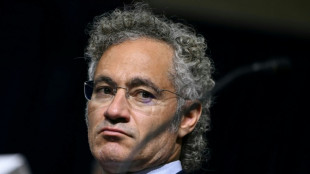
-
 LIV Golf switching to 72-hole format in 2026: official
LIV Golf switching to 72-hole format in 2026: official
-
'At home' Djokovic makes winning return in Athens

-
 Manchester City have become 'more beatable', says Dortmund's Gross
Manchester City have become 'more beatable', says Dortmund's Gross
-
Merino brace sends Arsenal past Slavia in Champions League

-
 Djokovic makes winning return in Athens
Djokovic makes winning return in Athens
-
Napoli and Eintracht Frankfurt in Champions League stalemate

-
 Arsenal's Dowman becomes youngest-ever Champions League player
Arsenal's Dowman becomes youngest-ever Champions League player
-
Cheney shaped US like no other VP. Until he didn't.

-
 Pakistan edge South Africa in tense ODI finish in Faisalabad
Pakistan edge South Africa in tense ODI finish in Faisalabad
-
Brazil's Lula urges less talk, more action at COP30 climate meet
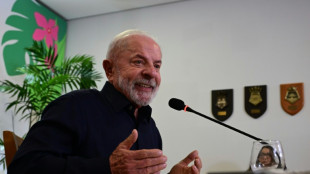
-
 Barca's Lewandowski says his season starting now after injury struggles
Barca's Lewandowski says his season starting now after injury struggles
-
Burn urges Newcastle to show their ugly side in Bilbao clash

-
 French pair released after 3-year Iran jail ordeal
French pair released after 3-year Iran jail ordeal
-
EU scrambles to seal climate targets before COP30

-
 Getty Images largely loses lawsuit against UK AI firm
Getty Images largely loses lawsuit against UK AI firm
-
Cement maker Lafarge on trial in France over jihadist funding

-
 Sculpture of Trump strapped to a cross displayed in Switzerland
Sculpture of Trump strapped to a cross displayed in Switzerland
-
Pakistan's Rauf and Indian skipper Yadav punished over Asia Cup behaviour

-
 Libbok welcomes 'healthy' Springboks fly-half competition
Libbok welcomes 'healthy' Springboks fly-half competition
-
Reeling from earthquakes, Afghans fear coming winter
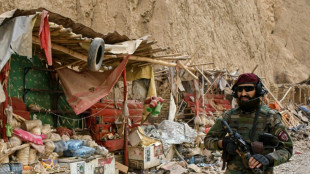
-
 Ronaldo reveals emotional retirement will come 'soon'
Ronaldo reveals emotional retirement will come 'soon'
-
Munich's surfers stunned after famed river wave vanishes
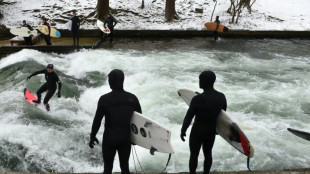
-
 Iran commemorates storming of US embassy with missile replicas, fake coffins
Iran commemorates storming of US embassy with missile replicas, fake coffins
-
Gauff sweeps Paolini aside to revitalise WTA Finals defence

-
 Shein vows to cooperate with France in probe over childlike sex dolls
Shein vows to cooperate with France in probe over childlike sex dolls
-
Young leftist Mamdani on track to win NY vote, shaking up US politics

-
 US government shutdown ties record for longest in history
US government shutdown ties record for longest in history
-
King Tut's collection displayed for first time at Egypt's grand museum

-
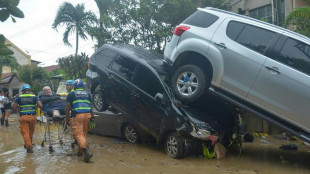 Typhoon flooding kills over 40, strands thousands in central Philippines
Typhoon flooding kills over 40, strands thousands in central Philippines
-
Trent mural defaced ahead of Liverpool return

-
 Sabalenka to face Kyrgios in 'Battle of Sexes' on December 28
Sabalenka to face Kyrgios in 'Battle of Sexes' on December 28
-
Experts call for global panel to tackle 'inequality crisis'
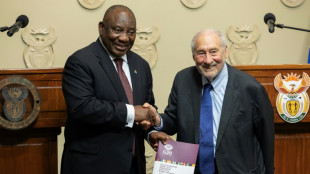
-
 Backed by Brussels, Zelensky urges Orban to drop veto on EU bid
Backed by Brussels, Zelensky urges Orban to drop veto on EU bid
-
After ECHR ruling, Turkey opposition urges pro-Kurd leader's release

-
 Stocks drop as tech rally fades
Stocks drop as tech rally fades
-
UK far-right activist Robinson cleared of terror offence over phone access

-
 World on track to dangerous warming as emissions hit record high: UN
World on track to dangerous warming as emissions hit record high: UN
-
Nvidia, Deutsche Telekom unveil 1-bn-euro AI industrial hub

-
 Which record? Haaland warns he can get even better
Which record? Haaland warns he can get even better
-
Football star David Beckham hails knighthood as 'proudest moment'
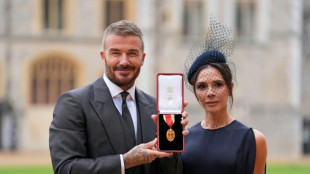
Nature guardians: Why Indigenous people are vital for saving biodiversity
For countless generations prior to European colonization, Canada's Indigenous people relied on caribou both as a source of subsistence and as an integral part of their cultural practices.
Hunting and butchering the animal in frigid temperatures was long seen as a rite of passage, and members of the First Nations were the first to detect their serious decline.
"Fundamentally we are people of caribou," Valerie Courtois, director of Canada's Indigenous Leadership Initiative and a member of the Innu nation, told AFP.
"Caribou is what has really enabled us to survive, and to be who we are."
Today the species, which is known as reindeer outside North America, is endangered across much of Canada as a result of widespread habitat destruction from logging, roadbuilding, construction of transmission lines and more.
But an innovative pilot program led by Indigenous people might show a path to wider recovery.
As delegates from across the world meet in COP15 in Montreal this week to hammer out a new deal for nature, the case highlights the value of Indigenous stewardship in protecting ecosystems that benefit all humanity.
As detailed in a March 2022 paper in "Ecological Applications," the Klinse-Za subpopulation of caribou in British Columbia were once so plentiful they were described as "bugs on the landscape" but by 2013 had dwindled to just 38 animals.
That year, the First Nations of West Moberly and Saulteau devised a plan that saw them first cull wolves to reduce caribou predation, then added a maternal pen-fenced enclosures for females to birth and raise calves.
Their efforts saw the number of caribou of the herd triple in the area from 38 to 114.
With the threat of localized extinction averted, the two nations signed an agreement in 2020 with the governments of British Columbia and Canada to secure 7,900 square kilometers (3,050 square miles) of land for caribou, hoping to eventually revive their traditional hunt.
"When you protect caribou, a lot of animals come along for the ride," Ronnie Drever, a conservation scientist with nonprofit Nature United, told AFP.
"Good caribou conservation is also climate action," he added, because the old-growth forests and peatlands they live on are invaluable carbon sinks.
- Science catching up -
Globally, Indigenous people own or use a quarter of the world's land, but safeguard 80 percent of remaining biodiversity -- testament to centuries of sustainable practices that modern science is only just starting to understand.
A paper published this October in Current Biology looked at tropical forests across Asia, Africa, and the Americas, finding those located on protected Indigenous lands were the "healthiest, highest functioning, most diverse, and most ecologically resilient."
A 2019 paper in Environmental Science & Policy analyzed more than 15,000 areas in Canada, Brazil and Australia.
It found that the total number of birds, mammals, amphibians and reptiles were highest on lands managed or co-managed by Indigenous communities.
Protected areas like parks and wildlife reserves had the second highest levels of biodiversity, followed by areas that were not protected.
"This suggests that it's the land-management practices of many Indigenous communities that are keeping species numbers high," said lead author Richard Schuster, in a statement.
- Partnership crucial -
Jennifer Tauli Corpuz, of the Kankana-ey Igorot people of the Philippines, who is a lawyer and biodiversity expert with the International Indigenous Forum on Biodiversity, stressed that collaborative efforts were crucial.
"Conservation does not have a good history with Indigenous peoples, it's resulted in displacement," she told AFP.
National parks established on Euro-American notions that the land was once pristine "wilderness" typically prohibited Indigenous peoples from exercising their customary land uses, and forcibly displaced many from their ancestral homes.
Instead, she says, the rights of Indigenous groups need to be woven into the fabric of the new global biodiversity deal -- including a cornerstone pledge to protect 30 percent of land and water by 2030.
Indigenous groups say they should have greater autonomy to take the lead as managers of protected areas, arguing their successful record demonstrates they can pursue economic activity sustainably.
"The current biodiversity crisis is often depicted as a struggle to preserve untouched habitats," said a study published last year in the Proceedings of the National Academy of Sciences, which found that areas untouched by people were almost as rare 12,000 years ago as they are today.
"Current biodiversity losses are caused not by human conversion or degradation of untouched ecosystems, but rather by the appropriation, colonization, and intensification of use in lands inhabited and used by prior societies," it concluded.
Q.Jaber--SF-PST

